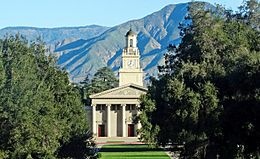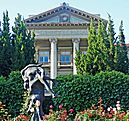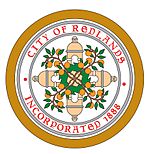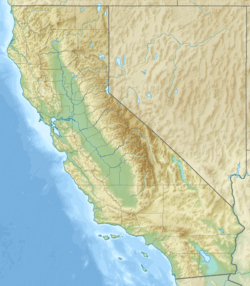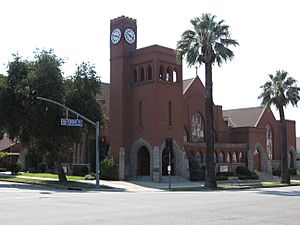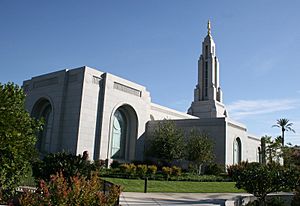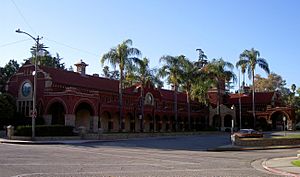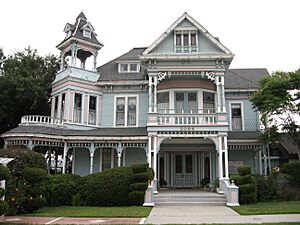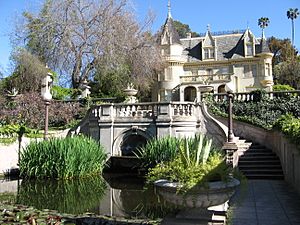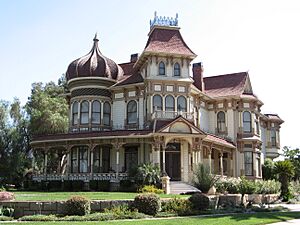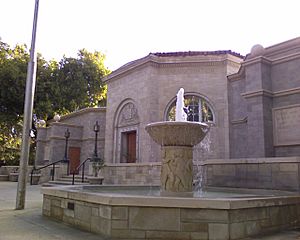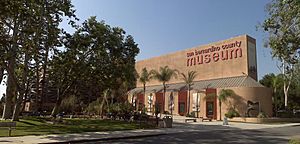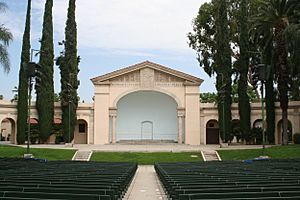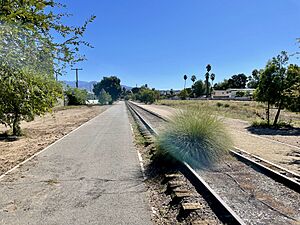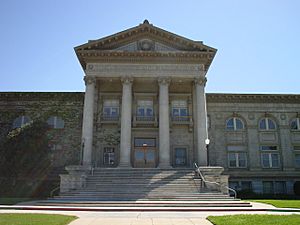Redlands, California facts for kids
Quick facts for kids
Redlands, California
|
|||
|---|---|---|---|
|
Clockwise: University of Redlands; historic Post Office; Redlands Police Station; historic Fox Theatre; University of Redlands
|
|||
|
|||
| Nickname(s):
"Jewel of the Inland Empire"
|
|||
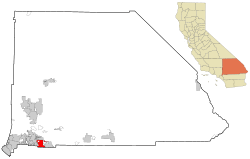
Location of Redlands in California
|
|||
| Country | United States | ||
| State | California | ||
| County | San Bernardino | ||
| Incorporated | December 3, 1888 | ||
| Named for | The red color of the adobe soil of the area | ||
| Government | |||
| • Type | Council-Manager | ||
| Area | |||
| • Total | 36.24 sq mi (93.87 km2) | ||
| • Land | 35.98 sq mi (93.20 km2) | ||
| • Water | 0.26 sq mi (0.67 km2) 0.83% | ||
| Elevation | 1,358 ft (414 m) | ||
| Population
(2020)
|
|||
| • Total | 73,168 | ||
| • Density | 2,018.98/sq mi (779.46/km2) | ||
| Time zone | UTC−8 (Pacific) | ||
| • Summer (DST) | UTC−7 (PDT) | ||
| ZIP Codes |
92373–92374
|
||
| Area code | 909 | ||
| FIPS code | 06-59962 | ||
| GNIS feature IDs | 0252966, 2411532 | ||
Redlands is a city in San Bernardino County, California, United States. In 2020, about 73,168 people lived there. This was an increase from 68,747 people in 2010.
The city is located about 45 miles (72 km) northwest of Palm Springs. It is also about 63 miles (101 km) east of Los Angeles.
Redlands was started in 1881 on land that belonged to the native Serrano, Morongo, and Cahuilla tribes. It became an official city in 1888. Redlands is home to the Asistencia Mission, which was built in 1819. In the early 1900s, Redlands was a big center for growing oranges. It was known for having the most navel oranges in the world.
Over the years, many generous people in Redlands helped create important places. These include the Smiley Library (1898), the University of Redlands (1907), the Redlands Bowl (1924), and the Lincoln Memorial Shrine (1932).
Today, Redlands is a growing community with different types of businesses. It is part of the Inland Empire area in Southern California. Redlands is also home to Esri, a major software company, and the San Bernardino County Museum.
Contents
History of Redlands
The land where Redlands is now was once home to the Morongo and Aguas Calientes tribes. In the 1770s, Spanish explorers came to the area. They wanted to spread the Catholic faith and expand the Spanish rule.
In 1810, a priest named Francisco Dumetz visited a village called Kaawchama. This village was just west of today's Redlands. He named the area the San Bernardino Valley after Saint Bernardino of Siena. In 1819, Franciscan friars from Mission San Gabriel built the San Bernardino Asistencia. They taught the native tribes how to farm and encouraged them to settle down. By 1820, the native people dug a ditch, called a zanja, to bring water from Mill Creek to the Asistencia.
In 1822, Mexico won its independence from Spain. The lands then became part of the new Mexican government.
Early Settlers and Lugonia
In 1842, the Lugo family bought the Rancho San Bernardino land. This was the first time settlers lived in the area permanently. The area northwest of Redlands, near the Santa Ana River, became known as Lugonia.
In 1848, the area became part of the United States after the Mexican-American War. By 1850, California was a US state. The first American settlers were Mormon pioneers. They bought the entire Rancho San Bernardino and started nearby San Bernardino. They built a successful farming community using water from the mountains.
In 1857, the Mormon community left. Benjamin Barton bought 1,000 acres (4.0 km2) of land. He planted many vineyards and built a winery. The first settler in what is now Redlands built a small hut in 1865. More settlers came to Lugonia in the late 1860s and 1870s.
Railroads and City Founding
In the 1880s, the Southern Pacific and Atchison, Topeka and Santa Fe Railroads arrived. This connected Southern California to San Francisco and Salt Lake City. It caused a land boom, with many people buying land.
Frank E. Brown and E. G. Judson started the city of Redlands. They wanted it to be a center for the growing citrus industry. They named the city "Redlands" because of the red color of the soil. The area grew so much that it became an official city in 1888. The communities of Lugonia, Bryn Mawr, Barton, and others joined Redlands. E. G. Judson became the first mayor.
The Redlands Street Railway Company started in 1888. It first used mule-team cars in 1889. In 1899, electric streetcars replaced the mules. Later, these lines became part of the Pacific Electric system.
The Pacific Electric Railway (PE) connected Los Angeles and San Bernardino in 1914. This made it easy to travel to Los Angeles and its port. Redlands became a popular vacation spot for wealthy people from Los Angeles. At its busiest, PE had five local routes in Redlands. The "Big Red Car" system ended service to Redlands in 1936.
Electricity Comes to Redlands
On July 27, 1892, a company was formed to bring electricity to Redlands. They built a power plant in Mill Creek canyon. This plant created the world's first three-phase electric power line. It brought electricity to Redlands and later became part of the Southern California Edison Co..
Electric arc lamps first lit up Redlands streets on August 5, 1893. By September, the company was selling power to homes. Even when gas lighting became available in 1900, many homes in Redlands already had electricity.
The Citrus Industry
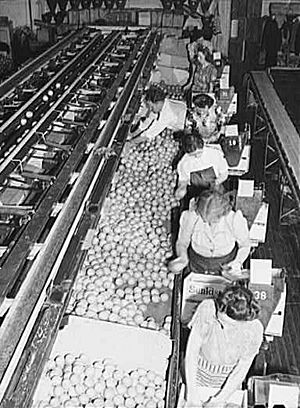
In 1882, Mr. E. J. Waite planted the first orange grove in Redlands. For almost 75 years, Redlands was the world's biggest producer of navel oranges. By the late 1930s, Redlands had over 15,000 acres (61 km2) of citrus groves. The city shipped thousands of railcars of oranges each year.
Over time, more farms were replaced by new neighborhoods. By the end of the 1900s, most of the citrus packing houses closed. Today, only one packing house remains to serve the smaller amount of citrus grown in the area.
Community Growth
In the early 1900s, Redlands was a beautiful place, like a "Palm Springs" of its time. Roses and palm trees were planted along the streets. The area was so pretty that the Santa Fe Railroad ran special "Kite Route" trains. These trains took people through the orange groves of Redlands and Mentone.
Today, a new train service called Arrow connects Redlands to San Bernardino. It started in 2022.
Three U.S. Presidents have visited Redlands: William McKinley (1901), Theodore Roosevelt (1903), and William Howard Taft (1909).
Famous landmarks include the A.K. Smiley Public Library, built in 1898 in a Moorish style. The Redlands Bowl, built in 1930, hosts the oldest free outdoor concert series in the United States. Behind the Smiley Library is the Lincoln Memorial Shrine. This is the only memorial honoring President Abraham Lincoln west of the Mississippi River.
Redlands is still known as the "Jewel of the Inland Empire."
In the mid-to-late 1900s, Redlands had many light manufacturing companies. It also became a home for military families from Norton Air Force Base. When Norton Air Force Base closed in 1994-1995, the local economy slowed down. The former base is now the San Bernardino International Airport.
Jack Dangermond started Esri, a software company, in 1969. By the year 2000, Esri was the largest employer in Redlands.
Geography and Climate
Redlands covers about 36.4 square miles (94.3 km2). Most of this area is land, with a small amount of water.
Climate
Redlands has a "dry-summer subtropical" climate, also called a "Mediterranean climate." This means it has hot, dry summers and mild, wet winters.
| Climate data for Redlands, CA | |||||||||||||
|---|---|---|---|---|---|---|---|---|---|---|---|---|---|
| Month | Jan | Feb | Mar | Apr | May | Jun | Jul | Aug | Sep | Oct | Nov | Dec | Year |
| Record high °F (°C) | 93 (34) |
92 (33) |
97 (36) |
106 (41) |
109 (43) |
114 (46) |
118 (48) |
113 (45) |
115 (46) |
110 (43) |
98 (37) |
90 (32) |
118 (48) |
| Mean maximum °F (°C) | 79.7 (26.5) |
81.3 (27.4) |
85.6 (29.8) |
91.5 (33.1) |
96.0 (35.6) |
101.5 (38.6) |
104.8 (40.4) |
104.6 (40.3) |
103.5 (39.7) |
96.8 (36.0) |
87.6 (30.9) |
80.2 (26.8) |
107.4 (41.9) |
| Mean daily maximum °F (°C) | 64.8 (18.2) |
66.1 (18.9) |
69.1 (20.6) |
73.8 (23.2) |
78.6 (25.9) |
86.8 (30.4) |
94.5 (34.7) |
94.3 (34.6) |
90.2 (32.3) |
81.0 (27.2) |
72.6 (22.6) |
65.8 (18.8) |
78.1 (25.6) |
| Mean daily minimum °F (°C) | 39.4 (4.1) |
41.3 (5.2) |
43.6 (6.4) |
46.8 (8.2) |
51.2 (10.7) |
55.2 (12.9) |
60.3 (15.7) |
60.7 (15.9) |
57.6 (14.2) |
51.3 (10.7) |
44.0 (6.7) |
39.6 (4.2) |
49.3 (9.6) |
| Mean minimum °F (°C) | 29.7 (−1.3) |
32.3 (0.2) |
34.7 (1.5) |
38.0 (3.3) |
42.8 (6.0) |
55.2 (12.9) |
60.3 (15.7) |
52.7 (11.5) |
49.1 (9.5) |
42.3 (5.7) |
34.6 (1.4) |
30.0 (−1.1) |
27.1 (−2.7) |
| Record low °F (°C) | 18 (−8) |
25 (−4) |
28 (−2) |
31 (−1) |
33 (1) |
40 (4) |
49 (9) |
46 (8) |
41 (5) |
28 (−2) |
26 (−3) |
23 (−5) |
18 (−8) |
| Average precipitation inches (mm) | 2.68 (68) |
2.64 (67) |
2.28 (58) |
1.17 (30) |
0.47 (12) |
0.10 (2.5) |
0.07 (1.8) |
0.15 (3.8) |
0.28 (7.1) |
0.69 (18) |
1.13 (29) |
1.89 (48) |
13.55 (345.2) |
| Source: WRCC | |||||||||||||
People of Redlands
| Historical population | |||
|---|---|---|---|
| Census | Pop. | %± | |
| 1890 | 1,904 | — | |
| 1900 | 4,797 | 151.9% | |
| 1910 | 10,449 | 117.8% | |
| 1920 | 9,571 | −8.4% | |
| 1930 | 14,177 | 48.1% | |
| 1940 | 14,324 | 1.0% | |
| 1950 | 18,429 | 28.7% | |
| 1960 | 26,829 | 45.6% | |
| 1970 | 36,355 | 35.5% | |
| 1980 | 43,619 | 20.0% | |
| 1990 | 60,394 | 38.5% | |
| 2000 | 63,591 | 5.3% | |
| 2010 | 68,747 | 8.1% | |
| 2020 | 73,168 | 6.4% | |
| U.S. Decennial Census | |||
Population in 2020
In 2020, Redlands had a population of 73,168 people.
- About 61.0% were White.
- About 6.3% were African American.
- About 8.1% were Asian.
- About 12.4% were from other races.
- About 36.8% of the people were Hispanic or Latino.
There were 25,273 households in Redlands. The average household had 2.77 people.
Population in 2010
In 2010, Redlands had a population of 68,747 people.
- About 69.0% were White.
- About 5.2% were African American.
- About 7.6% were Asian.
- About 12.0% were from other races.
- About 30.3% of the people were Hispanic or Latino. Redlands has a large Mexican-American community.
About 23.7% of the people were under 18 years old. About 13.1% were 65 years or older. The average age was 36.2 years.
Religions in Redlands
Before Europeans arrived, the local tongva and Serrano people had their own spiritual beliefs. The first Christian church in Redlands was the Catholic San Bernardino de Sena Estancia. It was built in 1819. This outpost was used to teach local Native Americans about Christianity.
Later, the land was sold to members of the Church of Jesus Christ of Latter-day Saints. They started a Mormon community in nearby San Bernardino. The Redlands California Temple is one of their temples in Southern California.
Redlands also has many other religions, including different Christian faiths, Judaism, and Islam. There is a group called the Redlands Area Interfaith Council. Many Seventh-day Adventist people live in Redlands and the nearby town of Loma Linda.
Economy and Jobs
Redlands has many different types of businesses. Here are some of the top employers in the city:
| # | Employer | Number of Employees |
|---|---|---|
| 1 | Esri | 2,700 |
| 2 | Redlands Unified School District | 2,277 |
| 3 | Redlands Community Hospital | 1,373 |
| 4 | Beaver Medical Group | 920 |
| 5 | University of Redlands | 543 |
| 6 | City of Redlands | 449 |
| 7 | Terracina Post Acute | 354 |
| 8 | Loma Linda University Behavioral Medical Center | 279 |
| 9 | The Home Depot | 269 |
| 10 | Amazon Fulfillment Center | 250 |
Arts and Culture
Historic Buildings
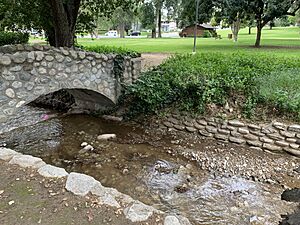
Many historic places in Redlands are listed on the National Register of Historic Places. These include:
Other important historic sites are:
- Barton Villa, built in 1877, is the oldest building in Redlands.
- Edwards Mansion, built in 1890.
- Morey Mansion, built in 1890, is known as "America's Favorite Victorian" home.
Museums to Visit
- The Lincoln Memorial Shrine is a museum about Abraham Lincoln and the American Civil War.
- The Museum of Redlands, inside the A. K. Smiley Library, shows local history.
- The Redlands Historical Glass Museum has American glassware from the 1800s to today.
- The San Bernardino County Museum teaches about local culture and nature.
Theater and Music
- The Fox Event Center, once the Fox Theatre (1928), now hosts live shows.
- The LifeHouse Theater is a community theater that started in 1993.
- The Redlands Bowl Summer Festival is the oldest free outdoor concert series in the United States. It takes place at the Redlands Bowl.
- The Redlands Symphony performs at the University of Redlands and the Redlands Bowl.
- The Redlands Theatre Festival is a summer theater festival that started in 1972.
Local Events
- Community July 4 is one of the biggest Independence Day celebrations in California.
- The Lincoln Pilgrimage happens every February. Over a thousand Scouts and young people honor President Abraham Lincoln.
Sports and Activities
- The Redlands Triathlon/Duathlon is held every February. You can choose to run, bike, and swim, or just run and bike.
- The Run through Redlands started in 1984. It's one of the biggest running events in the area, with races for all ages and distances.
Redlands also has a semi-professional soccer team called Redlands FC. They play in the USL League Two.
| Club | League | Sport | Venue | Established | Championships |
|---|---|---|---|---|---|
| Redlands Football Club | USL League Two | Association football | Dodge Stadium at Redlands High School | 2022 | 0 |
Fun Places to Visit
- Downtown Redlands: You can find restaurants and shops in this historic area.
- Escape Craft Brewery: A local brewery in an old building.
- J. Riley Distillery: Another local place to visit.
- Citrus Plaza/Mountain Grove: A large outdoor shopping center.
- Pharaoh's Adventure Park: This theme park was renamed Splash Kingdom Waterpark. It was used for TV filming, but it was taken down in 2020.
Parks and Recreation
The city of Redlands has 24 public parks, covering over 143 acres (0.58 km2). There are also 10 city-approved trails for walking and biking.
Education in Redlands
Colleges and Universities
- University of Redlands
- ESRI Learning Center
- Community Christian College
Public Schools
The Redlands Unified School District manages the public schools. Some notable high schools are:
- Citrus Valley High School
- Redlands East Valley High School
- Redlands High School
Private Schools
- Christ the King Lutheran Church and School
- Arrowhead Christian Academy
- Redlands Adventist Academy
- Sacred Heart Academy
City Services and Transportation
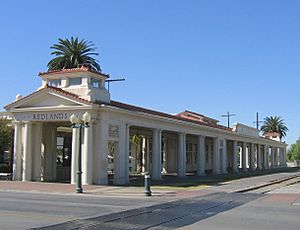
Highways
- Interstate 10: This major freeway opened in 1962.
- State Route 210 (the Foothill Freeway).
The Omnitrans bus system provides bus service in Redlands.
Train Service
The Arrow train offers commuter service from the University of Redlands to San Bernardino. It has stops in Redlands and began service in 2022. The San Bernardino Line of Metrolink also serves the Redlands–Downtown station.
Airports
- Redlands Municipal Airport is a general aviation airport for smaller planes.
- San Bernardino International Airport was once Norton Air Force Base.
Cemetery
Hillside Memorial Park Cemetery started in 1886. The city took it over in 1918.
Famous People from Redlands
- Matt Andriese, baseball player
- Ashley Argota, actress
- Joan Baez, folk singer
- Brian Billick, NFL coach
- Brant Bjork, musician
- Harry Blackstone Jr., magician
- Hugh "Lumpy" Brannum, actor (Mr. Green Jeans)
- Tyler Chatwood, baseball pitcher
- Tyler Clary, Olympic swimmer
- Jack Dangermond, founder of Esri
- Landon Donovan, soccer player
- James Fallows, journalist
- Davey Faragher, musician
- Johnny Hickman, musician (Cracker)
- Brion James, actor
- John Jorgenson, guitar player
- James LeGros, actor
- Jerry Lewis, former congressman
- Lil Xan, rapper
- David Lowery, musician (Camper Van Beethoven, Cracker)
- Doris Niles, dancer
- Kye Palmer, trumpet player
- Eric Pierpoint, actor
- Benji Schwimmer, dancer
- Lacey Schwimmer, dancer
- Naomi Smalls, drag queen
- Dave Stockton, professional golfer
- Dan Straily, baseball pitcher
- Mark Teahen, baseball player
- Joan Tewkesbury, film director
- The Tornadoes, surf rock band
- Brett Waterman, home preservationist
- Tom Wheeler, former FCC Chairman
- Josh Whitesell, baseball player
Sister Cities
Redlands has two sister cities:
 Hino, Japan
Hino, Japan San Miguel de Allende, Mexico
San Miguel de Allende, Mexico
See also
 In Spanish: Redlands (California) para niños
In Spanish: Redlands (California) para niños


